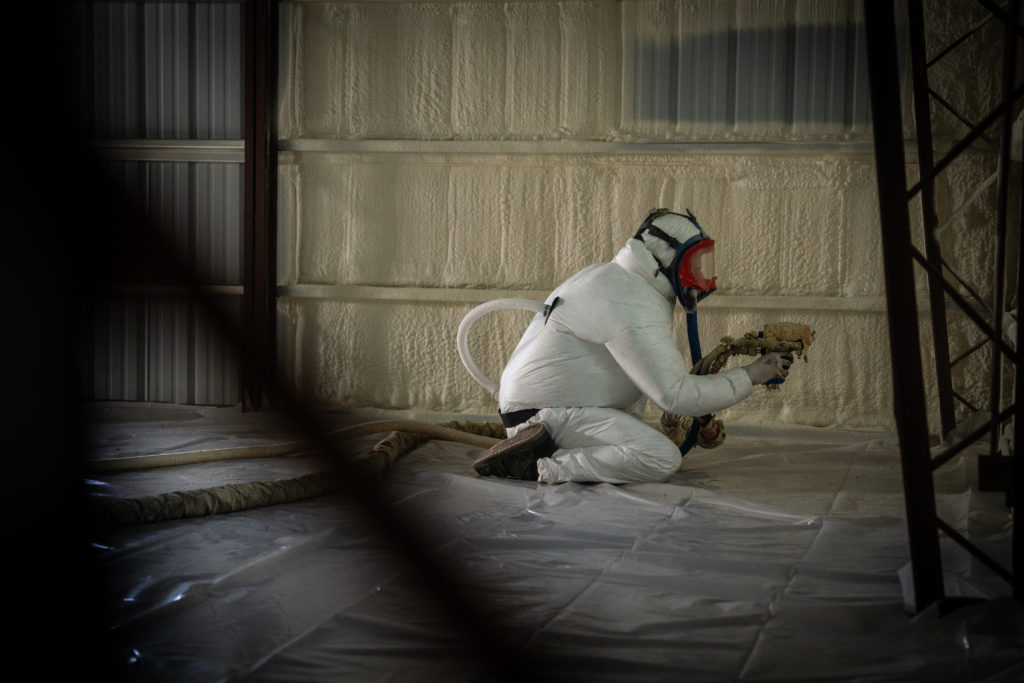
As summer temps start rising across North America, there’s plenty of attention to be given to the increased heat. The temperature certainly can affect your application of spray foam insulation, as we’ve covered before. But it would help if you also were mindful of the way moisture affects your application. In fact, moisture may be more important than temperature in ensuring a great application!
Moisture on the Substrate
You likely already know this, but it bears repeating: your substrate must be clean and dry. Moisture on the substrate is the enemy of good adhesion. High moisture content levels risk poor bonding and cell structure. This can easily be measured with a moisture probe before application. For wood substrates, the general industry guideline is no higher than 17% – 19% Wood Moisture Content. Any higher can affect the bond with the substrate and even cause off ratio applications as the excess water reacts with the Iso, potentially leading to “B Rich” foam.
Moisture in the Ambient Air
Relative humidity (RH) is the measure of moisture in the air. It measures water vapor in the air. Better put: how much moisture the air is “holding.” 100% RH means the air cannot hold any additional water vapor. Any extra water would come out of the atmosphere as fog or precipitation.
A 30º F day, for instance, with a 100% RH, may not “feel” that muggy. This is because of the low dew point (30º F). The dewpoint is the temperature at which air must be cooled to reach an RH of 100%. The higher the dewpoint, the “muggier” it will feel. The dewpoint can significantly affect spray foam application as well!
Avoid spraying foam when the ambient temperature is within 5º F of the dewpoint.
Moisture and Spray Foam Insulation
Poor application is most often the culprit when spray foam encounters moisture problems. Attics, by nature, are especially prone to swings in humidity levels. These are not conditioned spaces, and moisture from the rest of the home or structure naturally makes its way into the attic. Don’t believe us? Watch which direction steam (hot, moist air) goes in your kitchen or bathroom: up. And, there is nothing in attics to remove that moisture.
When the roof of a structure cools at night, the OSB or particleboard roofing deck pulls water vapor out of the air. Wood is hygroscopic, after all—it’s a porous material. The lower the temperature, the more moisture it can hold.
When the sun comes out in the daytime, it begins to warm the roof surface, and the radiant heat drives the moisture out of the roofing deck.
Open-cell spray foam insulation does not store moisture, however. Open-cell spray foam insulation acts as a pathway for moisture. Particularly humid climates or attics that regularly experience high humidity levels can have compounded issues, even when open-cell spray foam is applied.
Contrary to some murmurings in the industry, open-cell spray foam insulation does not cause roof rot when applied correctly in accordance with local building codes. For example, if you’re in an IECC Climate zone 5 or higher, you need a vapor retarder.
Before applying the insulation, take humidity and temp readings in the attic space. After installation, monitor the building’s attic relative humidity and temperature and ensure the attic is sealed airtight. This can be tested with a blower door.
Consider using a vapor retarder with open-cell foam, even in climates below IECC 5. Or, consider applying closed-cell foam. Keep in mind, though, that these measures won’t fix the high moisture levels in the attic; they’ll only help prevent rot of the sheathing.
Ultimately, you must reduce the amount of water vapor in a building’s attic. This can be accomplished with dehumidification, by conditioning the attic air, or proper attic exhausting.

Sorting It All Out
Thankfully, you have an advocate to get it right. If you have questions about moisture issues you’re experiencing, how to prep properly, or anything else spray foam related, we’re here for you. ; we’d be happy to help. And, if you’re already using Accufoam products, apply to be an Accufoam Certified Partner today. You’ll receive priority service, training, and membership benefits at no cost. Apply now!


